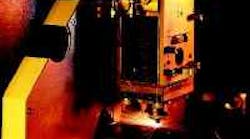Tube-cutting system performs multiple fabrication jobs in one continuous process.
Like its predecessor, the LT651 laser tube-cutting system, only faster, the LT652 also automates processing of round, square, rectangular, and oval tube stock.
With an LT651 or LT652 system, shops can laser cut tubular parts to length, profile end shapes, produce any shape of opening in tube walls, and add locating features to streamline assembly.
The loading-system bunker on an LT651 or LT652 accepts and automatically sorts different-shaped tube stock from bundles.
Processing tubular parts, especially those requiring added feat es, can shop floor's equipment for sawing, drilling, punching, machining, notching, and deburring. To boot, these machines require setups, manpower, and a way to move parts from one to the other. That is why shops may choose to clear the shop floor and streamline tube fabrication with a single machine integrating several operations.
The Lasertube LT651 laser tube-cutting system, from BLM-ADIGE USA Corp., Wixom, Mich., automatically processes round, square, rectangular, and oval tube stock — cutting it to length, profiling end shapes, and producing any shape of opening in the tube walls. In addition to eliminating the need for secondary machines, the LT651, according to its manufacturer, reduces labor up to 75%, eliminates the need for hard tooling that usually takes months to obtain, and slashes downstream assembly costs. Shops with the system have improved part quality and tolerances, added self-locating features to reduce the need for fixtures during assembly, and have easily incorporated robotic welding into their fabrication processes.
"When it comes to tube work, most shops are using methods that are 30+ years old," says James Rutt, president and COO of BLMADIGE USA. "The LT651 is made for shops doing parts requiring at least three fabrication steps. It tackles tough, hard-to-machine materials and small lot sizes because it sets up so quickly." Also, according to Rutt, the system gives product designers more freedom with less flack from the manufacturing end because it is flexible enough to handle most jobs.
The system runs on a Siemens 840 D 4-axis control and digital brushless motor drive. Its laser head moves transversally and vertically to accommodate different material shapes. Load capacity for the machine's tube bunker is up to 8,000 lb of material (200 lb per tube) for lengths up to 21 ft and diameters from 0.5 to 5.5 in. This bunker automatically unscrambles
and loads differently shaped tubes from bundles, then aligns them with the center of the machine's chuck, feeding in the proper length for material optimization.
The LT651's carriage-mounted chuck, with a long stroke and self-adjusting jaws, grips parts and manipulates them underneath the laser beam. The chuck-holding carriage traverses on precision re-circulating ball linear guides. A brushless motor, together with a rack and pinion, drive the carriage, a setup that eliminates backlash.
An optional delicate-tube-handling system moves parts without scratching them, especially useful for chrome workpieces. Furthermore, the machine has an optical weld-seam-detection device, so shops are aware of seam locations.
Ballscrews, also powered by brushless motors, move the machine's laser-focusing head transversally and vertically. For axial positioning, the machine employs a closed-loop control and position transducers delivering accuracies within ±0.002 in.
Because it comes preset, the LT651 accepts a special laser-beam focusing head with a capacitive sensor to automatically maintain a constant focal distance from the wall of the tube being processed, regardless of deformities or imperfections. This ensures a quality cut and eliminates collisions. The focusing head accommodates interchangeable lenses from 3.75 to 7.5-in. focal lengths. Changeover takes 10 sec, and the lenses withstand pressures up to 25 bar. The system operates on a choice of three assist gases selected from the CNC. A proportional valve lets users adjust the working pressure of two gases.
Through the LT651's CAD/CAM software, shops program as many as five separate parts from one raw tube length and cut parts in sets. The software also measures and records part cycle times to improve cost estimating for jobs.
Programming is performed in a Microsoft Windows 3.11 or 95 environment. Users can easily alter geometries according to parametric diagrams with free operational variables and move through the programming process step-by-step by inputting features from a CAD system in a DFX format.
In operation, the LT651 rapid traverses in the X axis (with chuck) at 3,543 ipm. Its X-axis stroke (with chuck) measures 255.905 in., Y axis is 6.692 in., and Z axis is 3.149 in.
Polaris optimizes production
One end user taking advantage of the benefits of the LT651 is Polaris Industries' fabrication plant in Osceola, Wis. The facility has two LT651s — the first was installed in 2000, the second in 2001.
The company produces suspension components for its snowmobiles using the LT651. The system pumps out about 150,000 trailing arms annually at a 75% reduction in labor. It also cuts the number of required operations from six to one and lets the shop use robotic welding.
On the ATV side, Polaris produces 80,000 swing-arm tubes annually on the LT651. The shop eliminates the need for dedicated tooling and processes the parts in one operation instead of three or four and at a 60% reduction in labor. As with the snowmobile parts, the LT651 also lets Polaris incorporate robotic welding into the swing-arm production.













